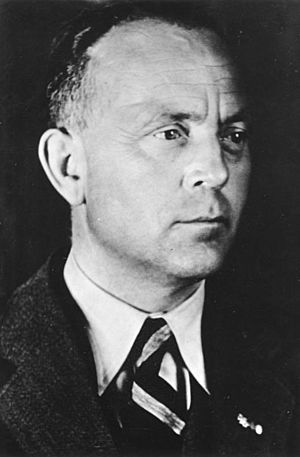Kurt Tank facts for kids
Quick facts for kids
Kurt Waldemar Tank
|
|
|---|---|

Prof. Dr. Dipl.-Ing. Kurt Tank, March 1941
|
|
| Born | 24 February 1898 Bromberg (Bydgoszcz), Province of Posen, German Empire
|
| Died | 5 June 1983 (aged 85) |
| Nationality | German |
| Education | Technical University of Berlin |
| Occupation | Engineer |
| Engineering career | |
| Projects |
|
| Awards | Honorary Professor with chair at Technical University of Braunschweig |
Kurt Waldemar Tank (born February 24, 1898 – died June 5, 1983) was a German aircraft engineer and test pilot. He was in charge of the design team at Focke-Wulf from 1931 to 1945. He helped create many important aircraft for the Luftwaffe (German Air Force) during World War II. These included the Fw 190 fighter plane and the Fw 200 Condor passenger plane. After the war, Tank designed planes in other countries for 20 years. He worked in Argentina and then in India. He later returned to Germany in the late 1960s.
Contents
Early Life and Military Service
Kurt Tank was born in Bromberg, which was part of Germany at the time. His family had a history of military service. His grandfather was a cavalry sergeant, and his father was a grenadier sergeant.
When World War I started, Tank wanted to join the air service. However, his father wanted him to join the cavalry instead. He followed his father's wishes and became a captain. He received many awards for being brave during the war.
Designing Aircraft: Kurt Tank's Career
After World War I, Kurt Tank went to the Technical University of Berlin. He graduated in 1923. A teacher from the university helped him get his first job. He worked at Rohrbach Metallflugzeug GmbH. There, he helped design flying boats and a passenger plane called the Ro VIII Roland.
Tank later moved to a company called Albatros Flugzeugwerke. He worked there as a test pilot. In 1929, Albatros went out of business. In 1931, it joined with another company called Focke-Wulf.
First Successful Designs at Focke-Wulf
At Focke-Wulf, Tank began working on the Fw 44 Stieglitz. This was a two-seat biplane for civilian use. It was Focke-Wulf's first design that sold well. It was launched in 1932.
In 1934, Tank's Fw 56 advanced trainer plane started being built. The company grew a lot as Germany began preparing for war.
The Fw 200 Condor: A Transatlantic Pioneer
In 1936, Tank designed the Focke-Wulf Fw 200 Condor. This plane was made for Deutsche Luft Hansa, a German airline. The first flight of the Condor happened in July 1937. Kurt Tank was the pilot for this flight.
In 1938, the Condor made a famous non-stop flight. It flew from Berlin to New York City. This flight showed that transatlantic air travel was possible. During World War II, the Condor was also used as a patrol bomber aircraft over the sea.
World War II Aircraft Designs
The Fw 190 Würger (Shrike) was a very important plane. It first flew in 1939 and was built from 1941 to 1945. It was a main single-seat fighter plane for the Luftwaffe during World War II. It was Tank's most famous design, with over 20,000 built.
In January 1943, Kurt Tank was given a special honor. He became an honorary professor at the Technical University of Braunschweig. This was to recognize his great work in developing aircraft.
In 1944, the German Air Ministry decided something new. All new fighter planes had to include the chief designer's name in their designation. So, Kurt Tank's new designs were given the prefix "Ta." His most important design late in the war was the Ta 152. This was a fast, high-altitude single-engine fighter. It was an improved version of the Fw 190 design.
Post-War Career and Legacy
After World War II, Kurt Tank looked for work in other countries. He talked with the United Kingdom, China, and the Soviet Union. When these talks didn't work out, he accepted an offer from Argentina. He went to work at their aerotechnical institute, the Instituto Aerotécnico in Córdoba. He used the name Pedro Matthies there.
Tank moved to Córdoba in late 1946. Many of his co-workers from Focke-Wulf went with him. At the institute, Tank designed the IAe Pulqui II. This plane was based on his Focke-Wulf Ta 183 design from the end of World War II. It was a very advanced design for its time. However, the project was stopped after President Juan Perón left power in 1955.
When Perón fell from power, Tank and his team went their separate ways. Many, including Tank, moved to India. First, he worked as a director at the Madras Institute of Technology. One of his students there was A. P. J. Abdul Kalam, who later became President of India. Kalam went on to design rockets and lead missile development programs.
Tank later joined Hindustan Aeronautics. There, he designed the Hindustan Marut fighter-bomber. This was the first military aircraft built in India. The first prototype flew in 1961. The Marut was used by the military until 1985.
Tank left Hindustan Aeronautics in 1967. By the 1970s, he had returned to live in Berlin, Germany. He worked as a consultant for MBB. Kurt Tank died in Munich in 1983.
Images for kids
See also
 In Spanish: Kurt Tank para niños
In Spanish: Kurt Tank para niños



